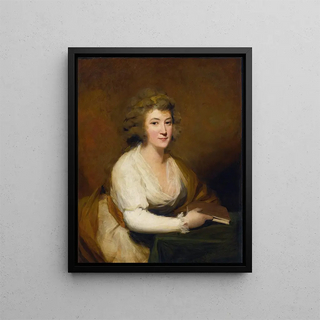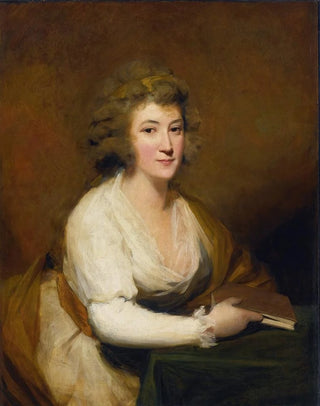Art print | Portrait of Lady Nasmyth in a white dress and brown shawl, sitting at a table holding a book - Sir Henry Raeburn


View from behind

Frame (optional)
In the fascinating world of 18th-century British painting, Sir Henry Raeburn's work stands out for its ability to capture the very essence of his subjects. The "Art print of Lady Nasmyth in a white dress and brown shawl, sitting at a table holding a book" is a shining example. This painting, depicting a woman of serene elegance, evokes a moment of reflection and intimacy. Lady Nasmyth, frozen in a moment of grace, appears immersed in her thoughts while holding a book, a symbol of knowledge and culture. The delicate light bathing the artwork highlights not only the beauty of her face but also the richness of the textures of her dress and shawl. This piece invites viewers to ponder Lady Nasmyth's personal story and the hidden narratives behind her contemplative gaze.
Style and uniqueness of the work
Raeburn's style is characterized by an exceptional mastery of portraiture, where every detail is carefully considered to reflect the personality and social status of his subjects. In the portrait of Lady Nasmyth, the chosen color palette, dominated by soft and warm tones, creates an inviting and intimate atmosphere. The drapes of her white dress contrast with the depth of the brown shawl, adding a tactile dimension to the piece. Raeburn excels in the art of light, using subtle shadows to shape Lady Nasmyth's face and body, giving her an almost lifelike presence. This realistic approach, combined with a certain idealization, allows the artist to transcend the simple portrait and offer a true study of character, where emotion and intellect meet.
The artist and his influence
Sir Henry Raeburn, often regarded as one of the greatest portraitists of his time, knew how to leave his mark on his era with his distinctive style and his ability to capture the soul of his models. Trained at the Edinburgh School of Fine Arts, he was influenced by the great European masters, while developing a unique approach that is entirely his own. His

Matte finish

View from behind

Frame (optional)
In the fascinating world of 18th-century British painting, Sir Henry Raeburn's work stands out for its ability to capture the very essence of his subjects. The "Art print of Lady Nasmyth in a white dress and brown shawl, sitting at a table holding a book" is a shining example. This painting, depicting a woman of serene elegance, evokes a moment of reflection and intimacy. Lady Nasmyth, frozen in a moment of grace, appears immersed in her thoughts while holding a book, a symbol of knowledge and culture. The delicate light bathing the artwork highlights not only the beauty of her face but also the richness of the textures of her dress and shawl. This piece invites viewers to ponder Lady Nasmyth's personal story and the hidden narratives behind her contemplative gaze.
Style and uniqueness of the work
Raeburn's style is characterized by an exceptional mastery of portraiture, where every detail is carefully considered to reflect the personality and social status of his subjects. In the portrait of Lady Nasmyth, the chosen color palette, dominated by soft and warm tones, creates an inviting and intimate atmosphere. The drapes of her white dress contrast with the depth of the brown shawl, adding a tactile dimension to the piece. Raeburn excels in the art of light, using subtle shadows to shape Lady Nasmyth's face and body, giving her an almost lifelike presence. This realistic approach, combined with a certain idealization, allows the artist to transcend the simple portrait and offer a true study of character, where emotion and intellect meet.
The artist and his influence
Sir Henry Raeburn, often regarded as one of the greatest portraitists of his time, knew how to leave his mark on his era with his distinctive style and his ability to capture the soul of his models. Trained at the Edinburgh School of Fine Arts, he was influenced by the great European masters, while developing a unique approach that is entirely his own. His






